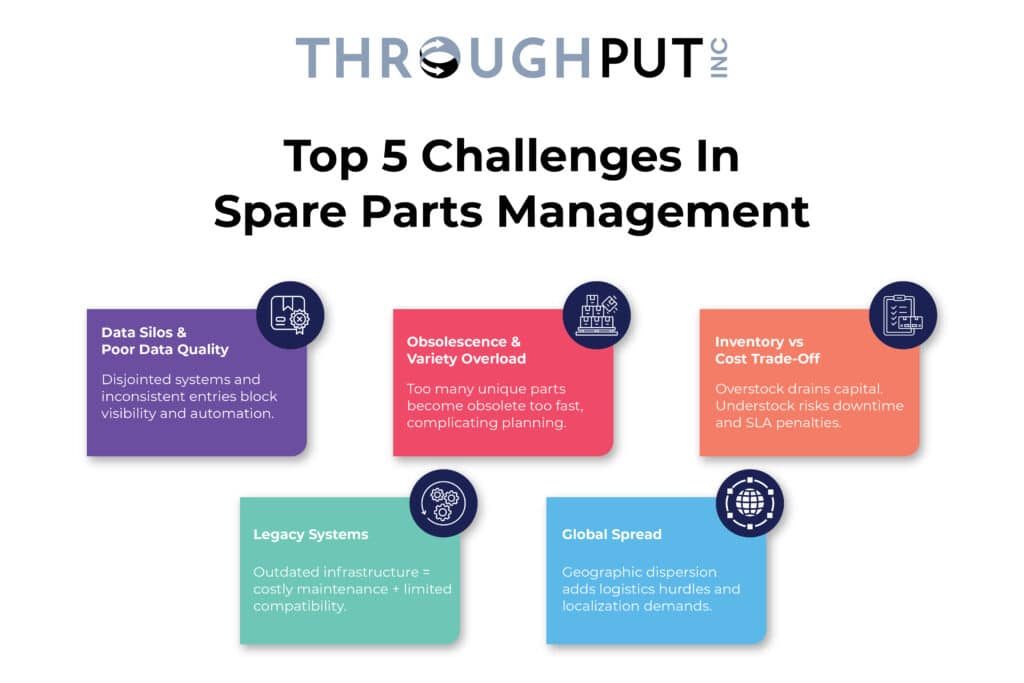In 2025, the landscape of spare parts management is undergoing a seismic shift. Maintenance, Repair, and Operations (MRO) professionals, heads of maintenance, and spare parts managers are navigating an environment shaped by supply chain volatility, legacy infrastructure, and an explosion of data. The stakes have never been higher: unplanned downtime due to unavailable parts can cost organizations thousands of dollars per minute, erode customer trust, and disrupt critical operations. To stay ahead of the curve, industry leaders are turning to data-driven strategies and artificial intelligence (AI) to transform how they manage inventory, forecast demand, and optimize the entire spare parts lifecycle.
This pillar post explores the evolving challenges, priorities, and solutions for three core personas—heads of maintenance and spare parts management, maintenance professionals, and MRO teams—offering a comprehensive guide to leveraging data and AI for next-generation spare parts management.
The Evolving Role of Spare Parts Management in 2025
Shifting Priorities and Challenges
- Heads of Maintenance and Spare Parts Management:
These leaders are under pressure to reduce costs, maximize asset uptime, and support sustainability goals. They must balance inventory investment with the risk of stockouts, manage obsolete parts, and ensure compliance with evolving regulations.
- Maintenance Professionals:
Maintenance teams are expected to move from reactive to predictive maintenance, requiring instant access to accurate parts data and real-time inventory levels. They face the daily challenge of identifying the right part, at the right time, for increasingly complex assets.
- MRO Teams:
MRO teams must coordinate with suppliers, manage global logistics, and ensure that spare parts are available across dispersed locations. They are also responsible for data integrity, vendor management, and aligning with enterprise sustainability initiatives.
Key Industry Trends Impacting Spare Parts Management: Deep Dive into Supply Chain Complexities, Tariffs, and Data Challenges
The spare parts management landscape in 2025 is shaped by a convergence of global supply chain complexities, evolving trade policies, and persistent data challenges. These factors create a dynamic environment where MRO and maintenance professionals must adapt quickly to maintain efficiency and control costs.
Increasing Complexity of Global Supply Chains
- Geographic Dispersion and Logistics:
As companies expand operations globally, managing the timely delivery of spare parts across multiple regions becomes more challenging. Differences in customs regulations, transportation infrastructure, and language barriers can delay shipments and complicate logistics, especially for critical or time-sensitive part.
The rise of e-commerce in B2B sectors is also transforming expectations for speed and transparency in spare parts delivery, pushing organizations to adopt more sophisticated logistics and tracking systems.
- Supplier Diversification and Sourcing Challenges:
Many organizations rely on a vast network of suppliers, sometimes numbering in the hundreds. This increases administrative complexity and introduces risks related to supplier reliability, lead times, and quality control. Sourcing bespoke or specialized parts from overseas can add further complications, such as minimum order quantities, anti-dumping regulations, and sustainability audits.
Tariffs and Trade Policy Volatility
- Impact on Costs and Availability:
Tariffs and protectionist trade measures have a direct impact on both OEM and aftermarket spare parts. When tariffs are imposed on imported parts or raw materials (such as steel and aluminum), production costs rise and are often passed down the supply chain, resulting in higher prices for end users.
Tariffs can also cause shipment delays, reduce product availability, and force companies to seek alternative suppliers or shift production to countries with more favorable trade agreements. However, these shifts can increase lead times and introduce new logistical and quality control challenges.
- Strategic Supply Chain Shifts:
To mitigate the impact of tariffs, organizations may diversify their supplier base or relocate sourcing to regions with lower tariffs. While this helps control costs, it can disrupt established supplier relationships and require new investments in supplier qualification and logistics.
Persistent Data Challenges
- Fragmented and Poor-Quality Data:
Many organizations still operate with fragmented, non-digitized MRO systems, leading to poor master data quality—duplicates, incomplete entries, and outdated parts information are common3. This lack of transparency hampers accurate demand forecasting, procurement efficiency, and inventory optimization.
- Lack of Real-Time and Cross-Location Visibility:
Without integrated systems, companies struggle to achieve visibility across production sites and regions. This results in high manual effort to identify and source parts, increased risk of stockouts or overstocking, and missed opportunities for cross-location inventory sharing.
- Integration and Process Gaps:
Even when new digital tools are introduced, integration with legacy ERP and IT systems can be challenging. Effective spare parts management requires not just technology, but also process changes and cross-functional collaboration to ensure data is standardized, cleansed, and actionable.
Demand Forecasting and Inventory Optimization
- Unpredictable Demand Patterns:
Unlike finished goods, the demand for spare parts is often sporadic and difficult to predict. This makes it challenging to balance inventory levels—too much stock ties up capital, while too little risks costly downtime.
- Lifecycle and Obsolescence Management:
The rapid evolution of equipment and product lines leads to a proliferation of unique parts, many of which quickly become obsolete. Managing the transition from old to new parts requires detailed lifecycle strategies and accurate data to avoid excess obsolete inventory.
Regulatory and Compliance Pressures
- Customs and Trade Compliance:
Navigating a web of international regulations, anti-dumping rules, and customs requirements adds another layer of complexity to global spare parts management. Non-compliance can result in shipment delays, fines, and reputational damage.

Summary Table: Key Trends and Their Impact
| Trend/Challenge | Description & Impact |
| Global Supply Chain Complexity | Multi-region operations, logistics, and customs challenges; need for advanced tracking and coordination |
| Tariffs and Trade Policy | Increased costs, shipment delays, and supply chain shifts; need for sourcing agility |
| Data Fragmentation | Poor master data quality, lack of real-time visibility, and integration hurdles |
| Forecasting Difficulties | Sporadic demand, risk of overstocking/stockouts, and lifecycle management issues |
| Regulatory Compliance | Navigating customs, anti-dumping, and sustainability requirements |
In 2025, successful spare parts management demands a holistic approach that addresses these interconnected trends—leveraging digital innovation, robust data strategies, and agile supply chain practices to stay resilient in the face of ongoing volatility and complexity.
Core Challenges in Spare Parts Management

- Data Silos and Poor Data Quality
Siloed systems and inconsistent data entries make it difficult to get a unified view of inventory, demand, and parts usage. Duplicate records, free-text entries, and missing information plague MRO master data, undermining automation and analytics initiatives.
- Obsolescence and Variety Management
The rapid evolution of product lines leads to a proliferation of unique parts, many of which become obsolete. Managing the phase-out of outdated stock while transitioning to new parts requires meticulous planning and data-driven insights.
- Inventory Optimization vs. Cost Control
Striking the right balance between minimizing inventory costs and ensuring high service levels is a perennial challenge. Overstocking ties up capital, while understocking risks costly downtime and missed SLAs.
- Legacy Infrastructure
Over 66% of enterprises still rely on outdated hardware and legacy systems, which are expensive to maintain and incompatible with modern digital solutions. Scarcity of parts for legacy systems exacerbates downtime and cost issues.
- Globalization and Geographic Dispersion
Managing spare parts across multiple regions introduces logistical complexities, customs regulations, and the need for localized inventory strategies.
The Data Dilemma: Why MRO Data Remains a Massive Challenge
Despite advances in ERP and asset management systems, MRO data quality remains a bottleneck:
- Duplicate and Inconsistent Records:
Multiple entries for the same part, inconsistent naming conventions, and free-text fields hinder analytics and automation.
- Incomplete Information:
Missing manufacturer details, part numbers, or specifications make it difficult to identify and source the correct parts.
- Unstructured Data:
Lack of standardized data formats complicates integration with AI and predictive tools.
Typical Sources of MRO Data:
- ERP and CMMS (Computerized Maintenance Management Systems)
- Supplier catalogs and vendor portals
- IoT sensors and connected asset data
- Maintenance logs and work order records
Types of Spare Parts Management Issues
| Issue Type | Description |
| Obsolescence | Parts no longer supported or manufactured, leading to sourcing challenges |
| Overstocking | Excess inventory ties up capital and increases holding costs |
| Stockouts | Insufficient inventory causes downtime and missed SLAs |
| Data Inaccuracy | Poor data leads to wrong orders, delays, and inefficiency |
| Siloed Operations | Lack of collaboration across teams leads to inefficiencies |
| Geographic Dispersion | Difficulty in managing parts across multiple locations |
How Throughput Spare Parts Management Empowers Maintenance Leaders, Professionals, and MRO Teams
What is Throughput Spare Parts Management?
Throughput spare parts management is a data-driven, AI-enabled approach that focuses on optimizing the flow of spare parts through the supply chain, from procurement to end-of-life. It leverages real-time data, predictive analytics, and unified digital platforms to ensure the right part is in the right place at the right time—minimizing downtime and maximizing asset performance.
How It Works
- Data Integration:
Aggregates data from multiple sources (ERP, IoT, supplier systems) into a unified platform, breaking down silos and ensuring a single source of truth.
- AI-Driven Forecasting:
Uses machine learning to predict demand, optimize safety stock, and flag potential obsolescence before it impacts operations.
- Dynamic Inventory Optimization:
Continuously adjusts inventory levels based on real-time usage, lead times, and risk factors, supporting just-in-time procurement and reducing excess stock.
- Lifecycle and Obsolescence Management:
Tracks parts through their lifecycle, automates phase-out planning, and proactively sources alternatives for obsolete items.
- Collaboration and Visibility:
Enables cross-functional teams (maintenance, procurement, suppliers) to collaborate on a single platform, improving responsiveness and reducing errors
Features and Benefits
| Feature | Benefit for Heads of Maintenance | Benefit for Maintenance Professionals | Benefit for MRO Teams |
| Unified Data Platform | End-to-end visibility, better decision-making | Easy access to accurate parts info | Streamlined supplier collaboration |
| Predictive Analytics | Reduced downtime, optimized budgets | Proactive maintenance scheduling | Improved demand forecasting |
| Automated Inventory Controls | Lower carrying costs, fewer stockouts | Faster part retrieval, less manual work | Efficient global inventory management |
| Obsolescence Tracking | Reduced risk of unplanned downtime | Reliable sourcing of critical parts | Smoother transitions to new parts |
| Real-Time Alerts & Reporting | Rapid response to issues | Immediate notification of shortages | Enhanced SLA compliance |
Improving the Maintenance Process with Data and AI
- Predictive Maintenance:
AI-powered systems analyze IoT sensor data to forecast equipment failures, enabling maintenance teams to schedule repairs before breakdowns occur. This reduces unplanned downtime and extends asset lifespans.
- Dynamic Scheduling and Resource Precision:
AI dynamically adjusts maintenance schedules and inventory orders based on real-time asset conditions and usage patterns, ensuring resources are deployed efficiently.
- Lean and Agile Operations:
By minimizing excess inventory and enabling just-in-time procurement, organizations can respond quickly to changing operational demands and market volatility.
The Impact: 2025 Statistics and Forecasts
- Downtime Costs:
The average cost of downtime due to hardware failure is approximately $9,000 per minute, making proactive spare parts management a critical cost-saving lever.
- Labor Shortages:
The aviation industry alone will require over 700,000 new maintenance technicians by 2042, intensifying the need for digital tools that boost productivity and knowledge sharing.
- Data Quality:
Over 60% of enterprises struggle with poor MRO data quality, leading to inefficiencies and missed opportunities for automation.
- Legacy Systems:
More than 66% of enterprises still rely on legacy hardware, with escalating maintenance costs and parts scarcity driving modernization efforts.
- Supply Chain Resilience:
Only 31% of companies are satisfied with their supply chain risk management effectiveness, highlighting the need for AI-driven scenario planning and real-time analytics.
See Throughput Spare Parts Management in Action
Staying ahead in 2025’s fast-evolving maintenance landscape requires more than incremental improvements—it demands a strategic, data-driven approach to spare parts management. Throughput spare parts management, powered by AI and unified data, empowers maintenance leaders, professionals, and MRO teams to overcome legacy challenges, optimize inventory, and deliver superior operational performance.

Top 10 Spare Parts Management FAQs
- How can AI help in predicting which spare parts I need?
AI looks at past data, equipment usage, and patterns to forecast which parts you’ll need—before you actually need them. This helps avoid last-minute emergencies and delays.
- How can I reduce machine downtime due to missing parts?
Tools like ThroughPut.ai help you track your inventory in real time, alert you when parts are running low, and even suggest reordering before it’s too late—so your machines don’t sit idle.
- What if I have bad data or old systems—can AI still help?
Yes! ThroughPut.ai can clean and fix bad inventory data, even from older systems like ERP or Excel sheets, and still give you clear recommendations without needing to change your current setup.
- How can I get rid of unused or obsolete spare parts?
The system can flag which parts haven’t been used in a long time and recommend whether to sell, reuse, or avoid buying again—saving you storage space and money.
- I manage parts across many plants—how do I keep track of everything?
ThroughPut.ai gives you one view of all your parts, across all locations. It even suggests sharing parts between plants to avoid duplicate buying.
- How can I avoid delays from import restrictions or price hikes?
The AI tracks trends in tariffs, supply chain risks, and vendor delays. It then recommends local suppliers or faster alternatives so you stay on schedule and budget.
- How do I know how much stock is “just right”?
Not too much, not too little—ThroughPut.ai studies usage trends and part importance to suggest the ideal stocking level for each part, helping you save money and avoid shortages.
- Will this work with my current ERP or Excel system?
Yes! You don’t need to buy a new system. ThroughPut.ai connects easily to your existing tools, giving you smarter insights without major changes
- Can it help me plan for future repairs and maintenance?
Yes, it looks at machine usage and past breakdowns to predict when a part might fail, so you can have it ready ahead of time—supporting predictive maintenance.
- What business results can I expect from this solution?
You’ll see fewer delays, better machine uptime, less wasted money on extra parts, and smarter purchase decisions. It’s also a big win for your bottom line and sustainability goals


